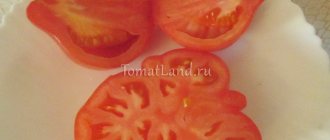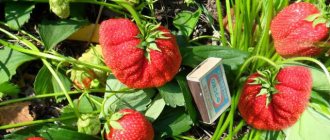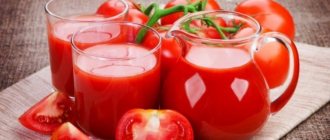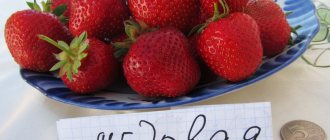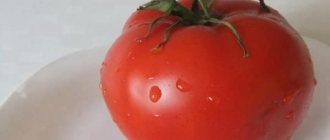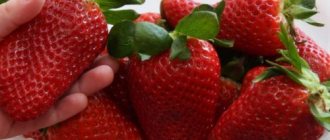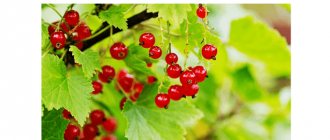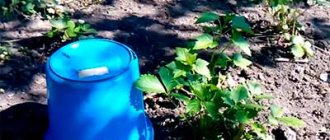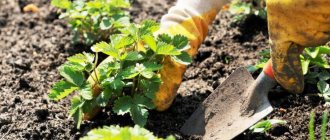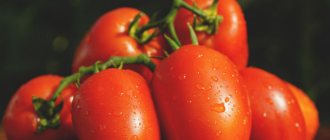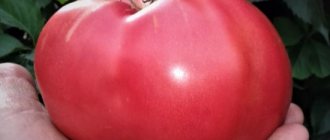Reproduction
Best with a mustache:
- 5-6 tendrils are selected from the mother plant, the developed rosettes are secured with pins, and the remaining tendrils are removed.
- Young rosettes can be rooted by placing them in cups filled with nutritious soil.
- To increase the amount of planting material, it is allowed to plant unrooted mustaches. In this case, the rosettes are cut off and then planted in a greenhouse, which is covered with white agrofibre. It is important to protect seedlings from the sun, wind, and ensure timely watering.
It is permissible to propagate the plant by seeds:
- Selected seeds are soaked in water for 2 days, after which they are sown without planting them in the soil.
- The planting is covered with glass, since the seeds require light, the container is placed in a warm place and kept at a temperature of 26 degrees.
- When the shoots appear, the temperature is reduced by a couple of degrees, making sure that there is no condensation in the greenhouse.
- The greenhouse should be gradually opened, but the agrofibre cannot be removed immediately, since the seedlings need time to get used to the new conditions.
- After a month, the plants are planted in another, wider container, and after another month - in separate pots.
- It is permissible to plant them in the garden at the moment when warm weather sets in. For the first time, it is recommended to cover them with agrofibre.
Another method of propagation is by dividing the bush:
- an old plant at the age of 3-4 years is dug up;
- divide the bush according to the number of rosettes;
- planting is carried out in the usual way.
Advantages
The main advantage of the Albion variety is its ability to bear fruit from May to October. There are also many other advantages:
- Drought resistance.
- Large fruits.
- A little mustache.
- High yield.
- Good storage capacity and preservation of presentation.
- Easy propagation using several methods.
- It is self-pollinating and can be grown in closed greenhouses
- Excellent immunity to most diseases, so it is possible to grow the variety without chemicals.
Some disadvantages include: poor tolerance to heat above +30 degrees, hollowness forms in the middle of the fruit due to incorrect growing techniques, chlorositis disease, and requires frequent care when caring for the plant in greenhouse conditions.
Landing
Since this is a remontant variety that bears fruit in spring, it is planted in late August - mid-September:
- First, choose the lightest area in the garden and add organic matter for digging. Rotted manure or compost with ash in an amount of 100 g/m2 or with 10 g of calcium chloride and 30 g of superphosphate is suitable.
- Strong seedlings with a developed root system are selected, their flower stalks are removed, and placed in a dark, damp place for 6 days.
- Before planting, they are soaked in a phytosporin solution for 1 hour. The solution is prepared at the rate of 1 tbsp. l. drug per 10 liters of water.
- Dig holes, between which there should be a distance of 25–30 cm. Between rows it should be 60–70 cm.
- They make mounds in the holes on which the seedlings are placed, after which the roots, previously trimmed to 7 cm, are straightened. In order for the plants to take root, their roots should not bend upward.
- The bushes are covered with earth. In this case, you need to strive to ensure that the central part is not too deep. If the weather is sunny, the seedlings are shaded for several days.
- Strawberries are mulched to prevent the soil from compacting and drying out. For these purposes, use pine needles, dried mown grass, straw or rotted sawdust.
Attention! It is advisable to plant strawberries in the evening or on cloudy days.
Description of Albion strawberries
Strawberry Albion (lat. Albion) forms powerful spreading bushes. The leaf blade is wide, jagged along the edges, slightly wrinkled, dark green. The peduncles are very powerful, erect, and rise above the foliage. When the berries are formed, the flower stalks do not bend to the ground.
Albion strawberries are remontant varieties. Fruit buds are formed under neutral day conditions. Flowering and fruit set occur continuously. Peak yields occur at the end of May, beginning of July, mid-August and the second half of September.
Strawberry Albion during flowering
Albion, located in the southern regions, has a number of features. The frost resistance of the variety is very low. Therefore, in the conditions of central Russia, when grown in open ground, the beds require shelter for the winter, without which the bushes will freeze out already at minus 10 degrees Celsius.
In summer, the Albion variety is also sensitive to weather conditions. On hot days, fruit set may stop completely and resume after the temperature normalizes. Damp, rainy weather negatively affects Albion strawberries - the berries become watery and tasteless.
Albion is resistant to strawberry diseases such as anthracnose and gray rot of fruits. Natural immunity to other infections is moderate. The variety is susceptible to attack by pests: strawberry and spider mites, nematodes, and strawberry weevils.
A description of the symptoms of infection with photos for the main strawberry diseases can be found in our article.
Strawberries of this variety begin to bear fruit a year after planting. Bushes planted in autumn will produce their first harvest next spring. The high productivity of the variety lasts 3-4 years, after which new strawberry beds are planted.
The yield of the variety, subject to agricultural technology, is high. From one bush you can collect up to two kilograms of juicy berries. In the northern regions, yields are declining sharply.
Watering
This berry is moisture-loving, so you need to water the plants often:
- If it's hot outside, watering is done every day. It must be drip.
- It is permissible to do moisture-charging irrigation. In this case, the beds are watered with 10-12 liters of water. This procedure is carried out once in May, April and June. This will eliminate the need to use drip irrigation.
- When the bushes bloom and fruits begin to form, they will need even more water: 20–25 l/sq.m.
Important! Water for irrigation should be at room temperature. Too cold water can damage leaves and bushes.
Care and feeding
To retain moisture in the soil, use mulch:
- hay or straw;
- black agrofibre;
- wood sawdust.
Mulch helps retain it and protects plants from overheating in hot weather.
Fertilizers for strawberries are necessary, since intensive fruiting depletes it. They are introduced during the formation of ovaries and during each flowering period.
For these purposes you can use:
- vermicompost;
- slurry;
- humus;
- ash;
- complex mineral fertilizers.
Pests and diseases
Strawberries can suffer from the following pests and diseases:
- chlorosis;
- white spotting;
- tick.
The following medications will help you cope with them:
- Azocene.
- A solution of copper sulfate, made at the rate of 20 g of the drug per 10 liters of water.
- Topaz.
- A solution of colloidal sulfur made at the rate of 60 g of the drug per 10 liters of water is destructive for ticks.
- Biofungicides - protect against rot.
Treatment is carried out after the snow melts, as well as during the first flowering period.
If the summer is rainy, strawberries may be threatened by slugs. To get rid of them, you should make your own trap:
- Take a jar with smooth edges.
- Dig it into the bed so that it is level with the ground.
- Pour some beer into the container.
Slugs will crawl towards the smell of a low-alcohol drink, fall into the trap and drown.
If a strawberry plantation has been chosen by wasps, you can reduce their population as follows:
- Take a plastic bottle.
- Cut it in such a way as to remove the middle part.
- Turn the top upside down and insert into the bottom.
- Pour jam or kvass into a container and place it in the garden bed.
Wasps caught in a trap will not be able to get out of it.
Interesting! Iodine helps improve the plant's natural immunity. 30 drops of iodine are dissolved in 10 liters of water and sprayed on the bushes.
Reviews from gardeners
There are quite a lot of reviews about this berry:
Stepan: “I have been growing Albion strawberries for three years now. At first it didn’t make me too happy - the bushes quickly withered and did not bear fruit. When I thought of mulching the beds with black agrofibre, the problems disappeared. I pick a lot of berries. There are no pests, weeds or diseases.”
Alexandra: “I love the variety, I want to say that in the summer the berries are much tastier than those picked in the spring. To ensure a stable harvest, it is necessary to fertilize regularly. If the summer is rainy, the berries may become watery.”
Oleg: “The variety is not very frost-resistant, it is quite vulnerable to attack by pests and diseases. If it is hot, the bushes may not bear fruit at all. But the taste of the fruit is beyond praise.”
Fruit characteristics
The description of strawberries required for Albion continues with a story about what its fruits look like. In general, large berries range from 30-50 g, their size increases due to fertilizing. The skin on the fruit is bright red with a pink core.
Note!
Eliane strawberries: advantages and disadvantages, choice of seedlings and how to care, detailed characteristics, planting time, reviews from gardeners, photos
Strawberries Gigantella - advantages and disadvantages, choice of planting site, growing recommendations, propagation options, reviews from gardeners
Weevil on strawberries - how to fight and get rid of it during flowering and fruiting, effective folk methods, photo of the pest
On one bush you can find heart-shaped, oval and oblong fruits, but for the most part the berries are equal and are great for sale.
The pulp is known for its high density, which increases the ability to lie down and be transportable, but is not to the taste of many gourmet gardeners.
